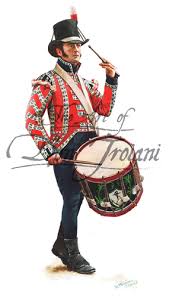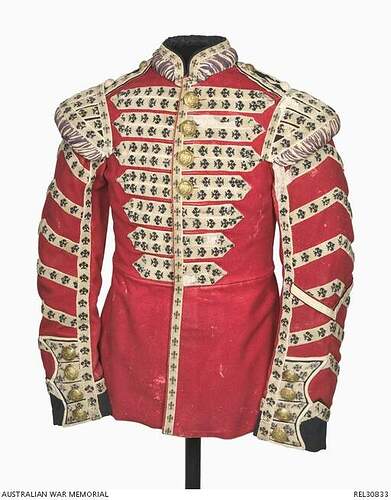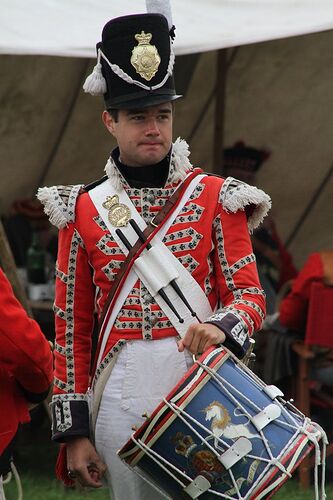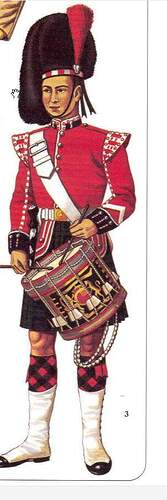Well said Bert. That drum needs no other work except for admiration … The detail is really fine as is and no one should be crazy enough to say its not. I have said it before and will probably say it again, as I have said about Lazarus and his figure builds and finishing. I have never seen better renditions and completed figures as his or these here. And the intricate attention detail on the tartan, water bottles, facial expressions etc etc etc etc. Platinum with diamonds award level … nothing less.
Tanks, Erwin! You too, Ryan!
Ain’t dat da trufe! I’m already fighting the fleur de lee pattern that runs up and down the bloomin coat. I’ve already decided if I can’t get it completely accurate, I’ll do the best I can and call it good. Lil Drummer Boy needs a swift kick in the pants for wearin such garb, sheesh! ![]()
![]()
![]()
Thanks, Johnny. It’s been a long haul, but we’re gettin close. Yes, I do like Lazarus’ work as well, he’s got it dialed in!
Did the Brits use the Fleur de Lis? It thought only the French used it?
You button counters are all alike, HA! That’s what it looks like to me, Erwin. If it’s just dots that would save me a ton of work, please advise. ![]()
Unless you show me where they go, I can’t tell…
Short answer is the Fleur de lis was used on British flags and uniforms well before 1815. It was first taken and used by an English king to represent his claim to the French throne and used on his royal standard / coat of arms and then transferred to others and uniforms.
The British military stole/borrowed a lot of French ideas about dress from their various battles… Shakos/ Bearskins, thigh jack boots for cavalry, cuirasses etc
Dang, Johnny, ya just ruined my day,… ![]()
![]()
![]() lol. Depression sets in,…
lol. Depression sets in,…
Ouch, I was afraid of this, but you are correct as far as I can tell. I was hoping to get by with dots or diamonds, but you’ve got a photo showing otherwise. Where the heck did you find this pic, I’ve scoured the web and couldn’t find anything specific?
The info from the pic says Australian War Musem and the cuffs are not accurate to the Black Watch and may be a different time frame, but I’ll be in stand-by mode until I can verify this intel.
All kidding aside, I greatly appreciate the intel. Sadly, off I go to fight the good fight, HA! Ah, this is gonna be the hoot of all hoots! Oh boy, oh boy, oh boy.
P.S. Aussie war museum shows the following: Australian Colonial Forces, 1854-1900
Sudan, 1885. so, I’m still looking.
It’s actually a Grenadier Guards drummers tunic, it was just for info really but most drummer tunics from that period would of probably had the Fleur de lis incorporated into the design. Usually like it is above, on the stand out white bands or the capped shoulder guards with their white banding etc… I will look for a period one ![]()
Here’s 2 period ones or images
This is another foot guards one.
And this one is a Royal Marines one.

Although the last one is blurry, the markings on the white stripping would be Fleur de lis…
Black watch are tricky to find but if there is white stripping/banding shown on it, and there are markings on that white stripe, good chance is it will be the Fleur…![]()
That drum is truly amazing Ski, you either have bionic eyes or a powerful magnifying glass…and the patience of a saint to boot…outstanding work, ![]()
![]() .
.
G, ![]()
Thanks for the ref pics, Johnny. I contacted the Black Watch Museum, standing by for a rply from the curator. Regardless, I’m not looking forward to doing these little fleur de lis, not at all, arggggggggg!
I recon the search engines don’t like me, cause you’ve come up with several pics I couldn’t find. Thanks again!
Hey G-man, thanks for stopping by. No, no bionic eyes like in my early 20’s but them #6 readers sure do help, HA! Patients, patients, patients,…Ha, you’ll have to refer to my lovely bride on that question, Bahahaaaaaaaaa!
Thanks for the correction… One is never too old to learn…
Erwin, we still love ya, man!
Ya, who’d a thunk it, Brits stealing something from the French? Say it ain’t so, wouldja! It’s funny how so much of what we see from back then has no real meaning to us because we don’t know the back story. There in lies the need to understand history, I recon.
I know the Brits had a large part of France once (Jeanne d’Arc died trying to correct this after all). I just didn’t expect that they would continue the use of the Fleur de Lis after having been booted…
You may be lucky … The only period ref images I have seen are the Fleur de lis on the white bands on the capped shoulder guards for Scottish drummer tunics…
1845 (according to Uniforms of The Black Watch)

I found a drawing that shows the drummer with a yellow jacket during the time?
And he has a different tartan pattern……
Just messing with you Steve, don’t you just love the help as your tripping over the finish line. ![]()
That’s mistitled, it actually shows the Gordons, 92nd Foot. However, it does highlight a feature of contemporary British military dress, in that drummers and fifers usually wore “reversed colours”, i.e., the coatee was facing colour, faced in red. As the 42nd was a royal regiment, theoretically the drummers would wear blue, faced red, but an order of 1812 stated that drummers of royal regiments should wear a red coat faced blue and this is almost certainly what was worn at Quatre Bras. Other line infantry seem to have been slow in changing colours, for example the 23rd Foot, Royal Welsh Fuzileers (sic) are shown in my reference with drummers in blue coats; 28th Foot (North Gloucestershire) in yellow;51st (2nd Yorkshire, West Riding) in green and 71st (HLI) in buff. Of course, the latter regiments are not royal, so the 1812 order didn’t apply. In the same reference, the Drum Major of the Black Watch is shown wearing a white coatee, but this looks like some form of parade dress. On the following page is a clear depiction of a drummers coatee from the 42nd in red with blue facings. The drummers lace, you will be pleased to hear, does not contain fleur-de-lis, but a simple repeating blue and white chevron, quite small, with the white dominating (i.e the white stripes are three times the width of the blue). The lace shows as five large double chevrons on each arm, i.e. five pairs of lace chevrons, and the lace is used as a single row to pipe the front seams, the arm seams, the wings, the shoulder straps, the turnbacks and all around the collar, top and bottom.


